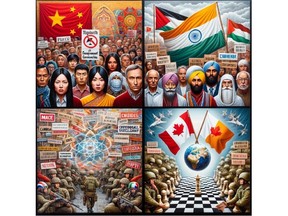Douglas Todd: Ethnic media reveals tough realities in migrant communities

Opinion: Hundreds of multi-lingual media outlets are the “canary in the coal mine,” offering warnings about everything from foreign interference to psychological stresses on newcomers

Article content
Canada could head off foreign influence and intimidation by monitoring the country’s proliferating ethnic media, according to a new report.
Hundreds of foreign-language newspapers, radio shows and TV stations in Canada offer revealing insights into the hopes and tensions experienced by more than eight million migrants and their offspring, says a study titled Diaspora Dynamics: Ethnic Media and Foreign Conflict in Multicultural Canada.
Advertisement 2
Article content
Article content
Canada’s ethnic media is “the canary in the coal mine,” offering warnings about everything from foreign interference to psychological stresses on newcomers, whether from Iran, China, Russia, India, South Korea, the Middle East or beyond, says Andrés Machalski, president of Multilingual International Media Research (MIREMS).
But governments aren’t taking advantage of the fertile resource. Their lack of understanding of the powerful role played by ethnic media has “enabled Chinese and Indian agents to (impact) public opinion … and provided an open door to homeland subversion of Canadian democracy,” says Machalski.
MIREMS’ 54-page report maintains the media outlets are invaluable for understanding what is going on in scores of diaspora communities.
The report goes so far as to suggest many newcomers suffer from anxiety and depression associated with “complex PTSD” as they try to navigate news and views from their homelands with their new lives in Canada.
Although many of the views expressed in ethnic media are predictable, there is some range of opinion, says the report by MIREMS, which tracks more than 800 media outlets in 30 languages in Canada and worldwide.
Article content
Advertisement 3
Article content
The discussion paper includes special sections on what the ethnic media says about China, the Russian-Ukraine war, the murder of a Sikh militant in B.C., and the Israel-Hamas war.
Here are some highlights:
Beijing’s infiltration of Chinese-language media in Canada
Jonathan Manthorpe, author of Claws Of The Panda: Beijing’s Campaign of Influence and Intimidation in Canada, wrote last week in The Vancouver Sun that one of the most “venomous” activities of the Chinese Communist Party is the way it controls “almost all Chinese-language media” in Canada.
“The result of this is most contemptible among new Canadians from Mainland China. This stranglehold blocks their exposure to Canadian society and values, and sustains CCP control over their lives,” Manthorpe wrote.
The MIREMS report does not go so far. But it does capture how Chinese-language newspaper and broadcast outlets, aimed at 1.7 million Chinese-Canadians, more often than not toe the Communist Party line on human rights abuses in Xinjiang, Hong Kong pro-democracy protests, the detention of Huawei CEO Meng Wanzhou, and China’s interference in Canadian elections.
Advertisement 4
Article content
Since many ethnic Chinese writers and editors in Canada fear they are being spied on by agents from Mainland China, the report says they often “shy away from controversial topics to protect their interests.” Still, MIREMS suggests a degree of independent reporting can be found.
Russian-Canadian media silent on the war against Ukraine
While the government-controlled media in Russia stridently promotes the devastating invasion of Ukraine, Machalski says that is not the case in the Russian-language media in Canada. “It is largely silent.”
Russian-Canadian media are significantly more “balanced” than those in the homeland — and are occasionally even sympathetic to Ukraine, says the report.
Russian, Ukrainian, Latvian and Polish media outlets in Canada serve a potential audience of more than two million people. If Ottawa had been learning from them, Machalski said, Prime Minister Justin Trudeau would likely have avoided the embarrassment of inviting a Ukrainian veteran who had fought for the Nazis to be honoured by Ukraine’s visiting prime minister, Volodymyr Zelensky.
Advertisement 5
Article content
Less emphasis on “World War III” in Jewish and Arab media in Canada
The mainstream media in Canada is generally more fair and nuanced than the diaspora media in covering most issues, including the Israel-Hamas war, says the report. But there can be surprises.
While Jewish-Canadian and Arab-Canadian outlets mostly contribute to polarization over the war in Gaza, Machalski, who is from Argentina, says there is at least not much talk about “how this is the start of World War III” — a theme that can emerge when mainstream outlets cover angry street protests.

South Asian media more open, and feisty
There has long been a range of opinions expressed in the various multi-language outlets serving South Asian-Canadians, a potential audience of almost two million.
Whether serving the country’s large Sikh or Hindu populations, media outlets are now fixated on how Canada’s diplomatic relations with India have been impacted by last year’s murder in B.C. of Khalistani separatist Hardip Singh Nijjar.
Sikh-oriented media outlets largely condemn India’s government, supporting Trudeau’s allegation that Indian agents could have been involved. On the other hand, Hindu-oriented outlets tend to accuse Trudeau of pandering to Sikh militants.
Advertisement 6
Article content
All in all, the MIREMS report concludes with the perceptive theory that it is psychologically disturbing for members of Canada’s sizeable diaspora populations, many of whom experience dual identities, to be buffeted by drastically contrasting messages from different media outlets.
“The constant exposure to homeland conflicts through ethnic media on one hand, and the mainstream media on the other, can be traumatic for immigrants, who find themselves caught between their past and present lives,” says the report.
“The coverage of ongoing conflicts such as those in Ukraine, India and the Middle East might trigger symptoms akin to Complex PTSD, where the stress is prolonged and repetitive.
“This form of psychological stress is complicated by immigrants’ efforts to integrate into Canadian society while maintaining ties to their country of origin, leading to a unique set of mental health challenges.”
Recommended from Editorial
-

Douglas Todd: Trudeau’s defiance of India ‘killing two birds with one stone’
-

Douglas Todd: Five things Canadians should know about the war in Ukraine
-

The political use and misuse of Canada’s ethnic media
Article content








